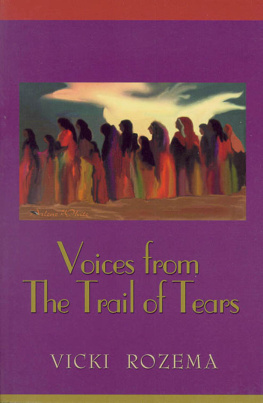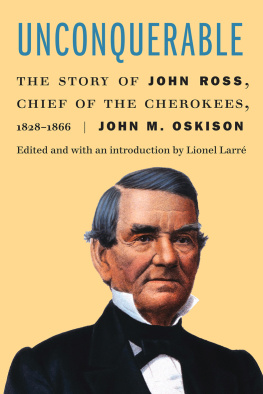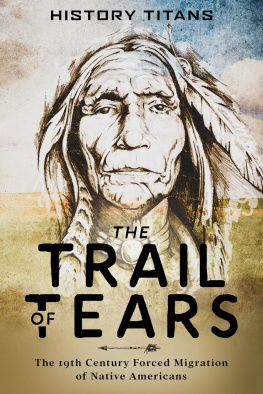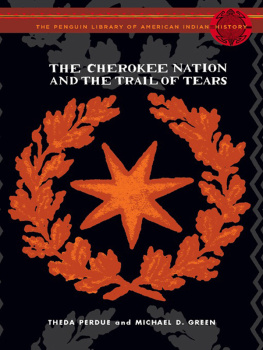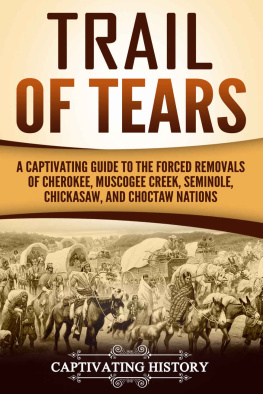Trail of Tears
Julia Coates

Copyright 2014 by ABC-CLIO, LLC
All rights reserved. No part of this publication may be reproduced, stored in a retrieval system, or transmitted, in any form or by any means, electronic, mechanical, photocopying, recording, or otherwise, except for the inclusion of brief quotations in a review, without prior permission in writing from the publisher.
Library of Congress Cataloging-in-Publication Data
Coates, Julia.
Trail of tears / Julia Coates.
pages cm. (Landmarks of the american mosaic)
Includes index.
ISBN 978-0-313-38448-6 (hardback) ISBN 978-0-313-38449-3 (ebook) 1. Trail of Tears, 18381839Juvenile literature. 2. Indians of North AmericaSouthern StatesRelocationJuvenile literature. 3. Cherokee IndiansHistoryJuvenile literature. 4. Cherokee IndiansRelocationJuvenile literature. I. Title.
E99.C5C668 2014
975.004'97557dc23 2013029453
ISBN: 978-0-313-38448-6
EISBN: 978-0-313-38449-3
18 17 16 15 14 1 2 3 4 5
This book is also available on the World Wide Web as an eBook.
Visit www.abc-clio.com for details.
Greenwood
An Imprint of ABC-CLIO, LLC
ABC-CLIO, LLC
130 Cremona Drive, P.O. Box 1911
Santa Barbara, California 93116-1911
This book is printed on acid-free paper 
Manufactured in the United States of America
Recent Titles in Landmarks of the American Mosaic
Wounded Knee
Martin Gitlin
Abolition Movement
Thomas A. Upchurch
The Chinese Exclusion Act of 1882
John Soennichsen
Cesar Chavez and the United Farm Workers Movement
Roger Bruns
Tuskegee Airmen
Barry M. Stentiford
Jim Crow Laws
Leslie V. Tischauser
Bureau of Indian Affairs
Donald L. Fixico
Native American Boarding Schools
Mary A. Stout
Negro Leagues Baseball
Roger Bruns
Sequoyah and the Invention of the Cherokee Alphabet
April R. Summitt
Plessy v. Ferguson
Thomas J. Davis
Civil Rights Movement
Jamie J. Wilson
Contents
Series Foreword
THE LANDMARKS OF THE AMERICAN MOSAIC series comprises individual volumes devoted to exploring an event or development central to this countrys multicultural heritage. The topics illuminate the struggles and triumphs of American Indians, African Americans, Latinos, and Asian Americans, from European contact through the turbulent last half of the 20th century. The series covers landmark court cases, laws, government programs, civil rights infringements, riots, battles, movements, and more. Written by historians especially for high school students, undergraduates, and general readers, these content-rich references satisfy thorough research needs and provide a deeper understanding of material that students might only be exposed to in a short section of a textbook or a superficial explanation online.
Each book on a particular topic is a one-stop reference source. The series format includes
This landmark series promotes respect for cultural diversity and supports the social studies curriculum by helping students understand multicultural American history.
Preface
NATIVE AMERICANS are noticeably absent from most histories of the United States. Appearing briefly in historical accounts of colonial times, Indians are presented as having aided the first colonists, or impeded their sociopolitical developments, or levied bloody attacks on their settlements. Always deemed marginal players to the central story of the European immigrants and their descendants who are described as those who built the American nation, American Indians have never warranted more than a few paragraphs in most texts used in American classrooms.
However, chances are that Indian Removal and the Trail of Tears were the subjects of at least one of those paragraphs. Americans who know nothing about Indians or Indian history may be able to correctly identify this event, although they often cannot provide any additional information or insight about it. The story of the forced removal of tens of thousands of Indians from their homes and homelands, and the deaths of thousands along the brutal marches that ensued is one that many Americans recall and an injustice they deplore.
This work brings depth to the story of Indian Removal in a way that is easily accessible for students and the general public. As a reference work, it will aid students to place this historic federal policy into the broader context of events and issues within the United States, but especially within the process of political and cultural responses offered by one of the most prominent Indian nations impacted by the policy, the Cherokees. Through a chronology that succinctly outlines the chapters to follow, biographies of the most significant historic figures of the era, primary documents, and an annotated bibliography, readers will not only have a strong introduction to the subject, but will also begin to comprehend the significance of the ongoing dialogue in contemporary times between the United States and the tribal nations within its borders.
I wish first to acknowledge two Cherokee scholars of their own history. Principal Chief Chad Smith of the Cherokee Nation provided an opportunity for me to contemplate and internalize this subject for years through teaching the Cherokee Nation history course that he originated. Tribal Councilman Jack Baker has shared information from his primary research that brings to life families and practices of the time period. Although not directly involved with this project, Theda Perdue, Anna Smith, Duane King, and Brett Riggs have provided detail and illumination over many years that have greatly changed my initial understanding of the preremoval and removal era. My cherished friendships with Kimberlie Gilliland, Andrew Sikora, Tom and Sally Lewis, and Cathy Monholland have supported me through a myriad of difficulties that impacted the timely delivery of the manuscript. To all, my profound gratitude.
Most especially, I have been profoundly influenced by the literally hundreds of hours that I have spent in conversation with Cherokee screenwriter Shane Smith on the subject of removal. His understanding of the humanity shared by all peoples that renders this a universal story lifts its telling from abject tragedy to highest inspiration. It is my most fervent hope that this work also reflects the enlightenment that he has shared with me.
And to my family, who for so many years have patiently supported an overworked daughter and sister who doesnt get to see them as much as she would like to, I love you.
Introduction
MANY GENERATIONS in the past, a people inhabited an island somewhere to the south of the present day United States. This small group lived on their island, surrounded by salty, undrinkable water, yet ventured out by canoe to gain great familiarity with the waters and the other islands around them. But after years and years of idyllic existence, their island started to tremble and shake and the day came when it began to spew forth fire. As these strange and unfamiliar events unfolded, the people collected themselves in their canoes and set out on the waters, escaping the terrifying changes that were occurring to their land. One by one the canoes left the shore, each loaded with islanders, until all were at last on the water. As they rowed further out to sea, the people in the last canoe turned to look back at their island, and in that moment, they saw it shattered by an explosion of fire. They continued to paddle away from it and eventually the horizon was empty, as if their homeland had never existed.


